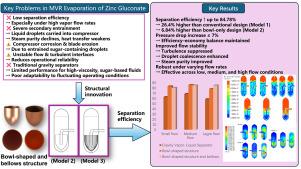Enhancing separation efficiency and secondary vapor quality in zinc gluconate evaporation: Application of a structurally innovative vapor–liquid separator
IF 3.9
3区 工程技术
Q3 ENERGY & FUELS
Chemical Engineering and Processing - Process Intensification
Pub Date : 2025-10-08
DOI:10.1016/j.cep.2025.110569
引用次数: 0
Abstract
To overcome the low secondary vapor quality and insufficient separation efficiency in zinc gluconate evaporation systems, a novel vapor–liquid separator integrating a bowl-shaped bottom plate and corrugated tubes was developed using CFD simulation. Three separator designs were evaluated: a conventional gravity-settling separator (Model 1), an improved version with a bowl-shaped bottom (Model 2), and a hybrid structure combining a bowl-shaped bottom with corrugated tubes (Model 3). Under varied flow rates, the internal flow characteristics, pressure distribution, separation efficiency, and pressure drop were systematically investigated. Results showed Model 2 improved separation efficiency by 17.2%–20.7% compared to Model 1. Model 3 achieved the highest efficiency of 84.78%, exceeding Model 1 by 26.37% and Model 2 by 6.84%, while maintaining a modest pressure drop increase (5%–7%). Analysis revealed that the combined ”contraction–expansion” channels and micro-vortices generated by the corrugated tubes enhanced droplet coalescence, stabilized interfaces, extended droplet residence time, and improved adaptability to flow fluctuations. This study provides valuable insights and practical guidance for optimizing vapor–liquid separator design and enhancing operational efficiency in zinc gluconate evaporation systems.

提高葡萄糖酸锌蒸发的分离效率和二次蒸汽质量:一种结构创新的汽液分离器的应用
针对葡萄糖酸锌蒸发系统中二次蒸汽质量低、分离效率不高的问题,采用CFD模拟技术,研制了一种新型的碗形底板和波纹管相结合的汽液分离器。对三种分离器设计进行了评估:传统的重力沉降分离器(模型1),改进的碗形底部分离器(模型2),以及碗形底部与波纹管相结合的混合结构分离器(模型3)。在不同的流量下,系统地研究了内部流动特性、压力分布、分离效率和压降。结果表明,与模型1相比,模型2的分离效率提高了17.2% ~ 20.7%。模型3的效率最高,达到84.78%,比模型1和模型2分别高出26.37%和6.84%,同时压降增幅不大(5%-7%)。分析表明,波纹管“收缩-膨胀”通道与微涡的结合增强了液滴的聚结,稳定了界面,延长了液滴的停留时间,提高了对流动波动的适应性。该研究为优化汽液分离器设计和提高葡萄糖酸锌蒸发系统的运行效率提供了有价值的见解和实用指导。
本文章由计算机程序翻译,如有差异,请以英文原文为准。
求助全文
约1分钟内获得全文
求助全文
来源期刊
CiteScore
7.80
自引率
9.30%
发文量
408
审稿时长
49 days
期刊介绍:
Chemical Engineering and Processing: Process Intensification is intended for practicing researchers in industry and academia, working in the field of Process Engineering and related to the subject of Process Intensification.Articles published in the Journal demonstrate how novel discoveries, developments and theories in the field of Process Engineering and in particular Process Intensification may be used for analysis and design of innovative equipment and processing methods with substantially improved sustainability, efficiency and environmental performance.

 求助内容:
求助内容: 应助结果提醒方式:
应助结果提醒方式:


